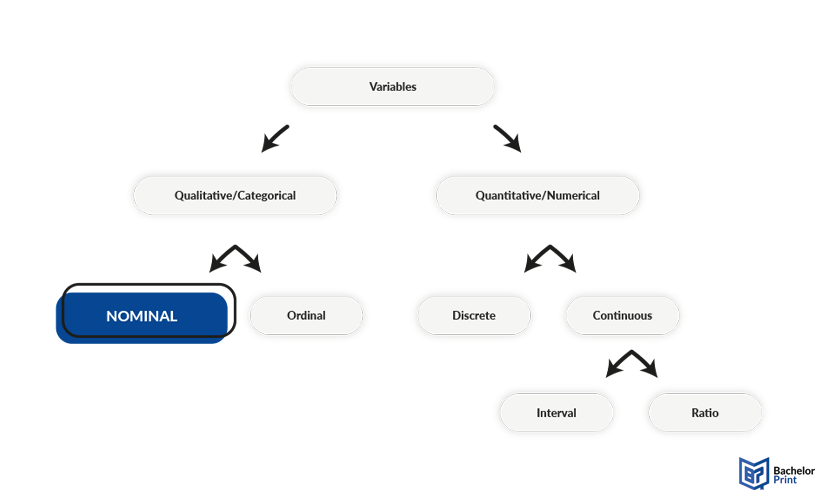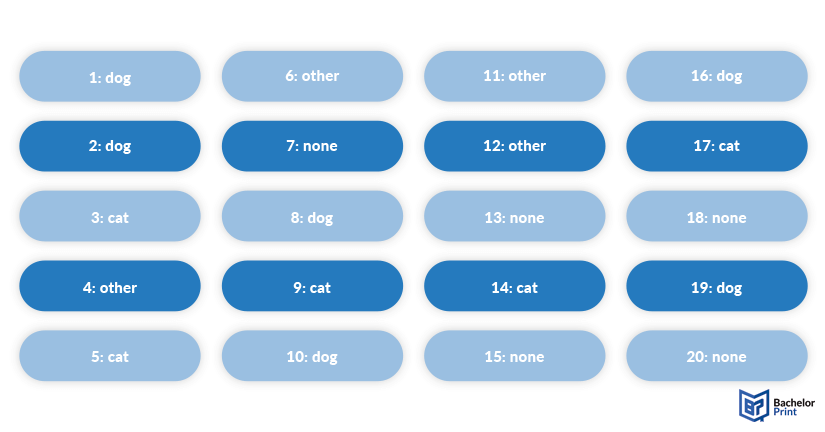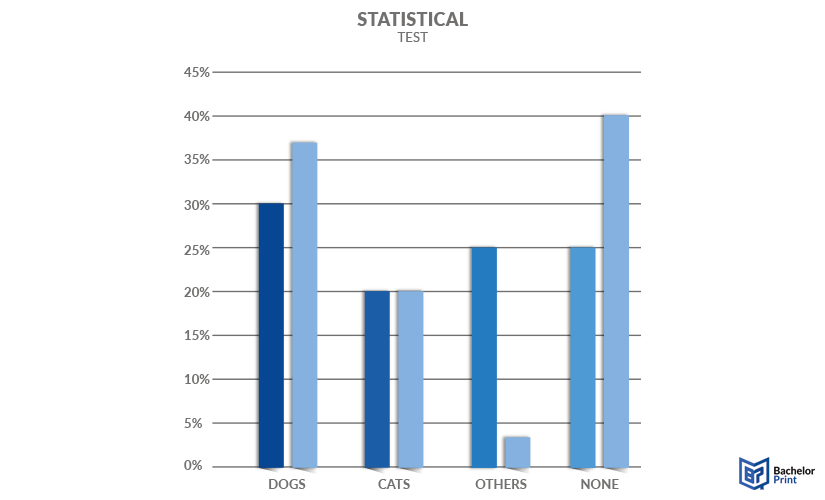
Variables are a highly valuable tool in research, as they help to define what you have, what you do, and what you expect. Therefore, different types of variables serve different purposes in statistical methodology. One of these is the nominal variable, an elementary one that consists of logically separate categories. The use of nominal variables, along with explanations and examples, will be discussed in the following article.
Definition: Nominal variables
Nominal variables are a type of categorical variable. In some cases, they are used as a synonym for categorical variables, while they are actually a subgroup. Nominal variables consist of two or more logically separate categories, which cannot be ranked or evaluated. They are qualitative data, mostly presented as words.
These categories could, in statistics, be replaced by numbers. For instance, in the second example, you could also assign the number “1” to male, “2” to female, and “3” to non-binary. Just keep in mind that these numbers cannot be used in statistical calculations, as they serve as an alternative placeholder for a word.
Nominal data can also primarily consist of numbers, such as in zip codes and ID numbers, which are composed of digits but do not hold any statistical value.

Nominal vs. ordinal variables
Both nominal and ordinal variables are subtypes of categorical variables, also called qualitative variables. Neither holds any statistical quantitative value and therefore cannot be used in a calculation. These types of variables merely state facts or subjective evaluations.
Nominal variable
Nominal variables consist of distinct categories, which rarely allow you to choose two or more simultaneously. The options to pick from cannot be ranked in hierarchical levels due to being logically separate.
Ordinal variable
Ordinal variables, on the other hand, always include a hierarchy or ranking. This can be done either by numbers or descriptions, mostly on a scale of odd numbers such as 3, 5, or 7.
Types of nominal variables
Nominal variables can be distinguished into two major categories: binary variables and category variables.
Binary variables
Binary variables, sometimes also called dichotomous variables, are the simplest form of nominal data. They consist of only two options or categories and find various applications in research and IT. Generally speaking, binary variables are always nominal.
The only exception where a binary variable can be considered ordinal might be when you, for example, ask if a movie was good or bad, and you give your responder only these two options. Then you can rate or evaluate the answer, since good is better than bad. But in most cases, you would want to have more expressive results by using a scale with three, five, or seven gradations.
Multiple category variables
Multiple category variables are simply those that have more than two categories, just as the name suggests. However, multiple categories can be present in nominal variables as well as in ordinal variables.
Nominal variables can never be ranked or ordered, as the options all stand individually, while ordinal variables can always be rated. In conclusion, this means that multiple category variables can be nominal as well as ordinal in nature, depending on the research question and subsequently the categories or answer options.
Multivariate variables with nominal base
Nominal variables are always defined as logically separate concepts, from which you may only choose one option. However, there are also multiple-choice questions in the phrasing of “tag all that apply to you,” meaning you can select more than one option. These are called multivariate variables with a nominal base. The categories are still distinct but leave room for two or more options to be picked.
Analyzing nominal data
There are many ways or steps in analysing nominal data, which will be explained in the following paragraphs. To help you understand each of them better, the following example will be used to visualize the explanations.

Frequency
To analyse nominal data, you first need to make a list of the data you have collected, then count the absolute frequency of the results. By dividing the absolute frequency by the absolute number of answers/participants, you get the relative frequency in percentage. These outcomes can then be visualized in different types of diagrams, for example, a bar diagram or a pie chart.
Dogs
Cats
Others
None
6
4
5
5

Dogs
Cats
Others
None
30%
20%
25%
25%

Mode
Moreover, you can also define the mode of your data set, meaning the most frequent answer given. Other measures, like the mean or the median, cannot be defined in nominal data, as they contain no ranking or real statistical value. If you have already found the absolute and relative frequency of your data set, the answer with the highest number is the mode of your distribution.
Statistical test
Nominal variables can be statistically analysed through a chi-square test by comparing the absolute frequency to the expected frequency. This is possible because frequency itself is not a nominal variable but a quantitative variable. The expected frequency in this case is simply taken from prior studies found on the internet and not validated. These numbers simply serve as an example. The left bar is always the results of our own sample, while the right bar represents our expected values.

Other types of variables
- Categorical variables and qualitative variables
- Quantitative variables and numerical variables
- Nominal variables
- Ordinal variables
- Discrete variables
- Continuous variables
- Interval variables and ratio variables
- Random variables
- Latent variables
- Composite variables
- Binary variables
numerous advantages for Canadian students:
- ✓ 3D live preview of your configuration
- ✓ Free express delivery for every order
- ✓ High-quality bindings with individual embossing

FAQs
Nominal data can be any data that does not contain a ranking or quantitative values. Examples can be the marital status, the possession of a driving license, or the blood type, but also simple things like colors or different species of animals. Everything through which you can categorize people or objects.
A nominal variable is characterized by its distinct categories, which cannot be sorted into a hierarchy or ranking of any sort. The simplest variable on a nominal scale is the binary variable, which always has only two outcomes, such as “yes” or “no.”
Both nominal and ordinal variables belong to the group of categorical variables and are thus very similar. Neither holds a calculable value for statistics but only categorizes something. However, while nominal variables cannot be ranked but have to be considered as individual separate categories, an ordinal scale always follows a ranking or hierarchy.
These two do sound very similar, so watch out to distinguish them.
- A nominal variable categorizes people or objects by a non-quantitative value. These categories are logically separate, meaning they exclude each other.
- A numerical variable is a quantitative variable. This means that its value also holds statistical value and can be used in calculations.